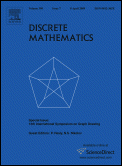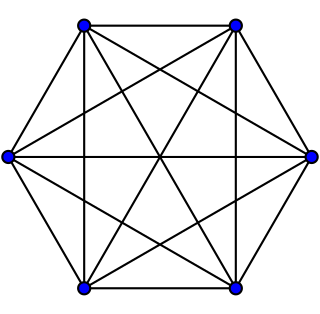Related Research Articles

An m,n,k-game is an abstract board game in which two players take turns in placing a stone of their color on an m-by-n board, the winner being the player who first gets k stones of their own color in a row, horizontally, vertically, or diagonally. Thus, tic-tac-toe is the 3,3,3-game and free-style gomoku is the 15,15,5-game. An m,n,k-game is also called a k-in-a-row game on an m-by-n board.
In mathematics, Property B is a certain set theoretic property. Formally, given a finite set X, a collection C of subsets of X has Property B if we can partition X into two disjoint subsets Y and Z such that every set in C meets both Y and Z.
In combinatorics, the Dinitz theorem is a statement about the extension of arrays to partial Latin squares, proposed in 1979 by Jeff Dinitz, and proved in 1994 by Fred Galvin.

In graph theory, a circle graph is the intersection graph of a chord diagram. That is, it is an undirected graph whose vertices can be associated with a finite system of chords of a circle such that two vertices are adjacent if and only if the corresponding chords cross each other.

In the mathematical area of graph theory, a triangle-free graph is an undirected graph in which no three vertices form a triangle of edges. Triangle-free graphs may be equivalently defined as graphs with clique number ≤ 2, graphs with girth ≥ 4, graphs with no induced 3-cycle, or locally independent graphs.
Harary's generalized tic-tac-toe or animal tic-tac-toe is a generalization of the game tic-tac-toe, defining the game as a race to complete a particular polyomino on a square grid of varying size, rather than being limited to "in a row" constructions. It was devised by Frank Harary in March 1977, and is a broader definition than that of an m,n,k-game.

In the mathematical field of graph theory, a graph G is said to be hypohamiltonian if G itself does not have a Hamiltonian cycle but every graph formed by removing a single vertex from G is Hamiltonian.

In graph theory, a starSk is the complete bipartite graph K1,k : a tree with one internal node and k leaves. Alternatively, some authors define Sk to be the tree of order k with maximum diameter 2; in which case a star of k > 2 has k − 1 leaves.

In the study of graph coloring problems in mathematics and computer science, a greedy coloring or sequential coloring is a coloring of the vertices of a graph formed by a greedy algorithm that considers the vertices of the graph in sequence and assigns each vertex its first available color. Greedy colorings can be found in linear time, but they do not, in general, use the minimum number of colors possible.

Discrete Mathematics is a biweekly peer-reviewed scientific journal in the broad area of discrete mathematics, combinatorics, graph theory, and their applications. It was established in 1971 and is published by North-Holland Publishing Company. It publishes both short notes, full length contributions, as well as survey articles. In addition, the journal publishes a number of special issues each year dedicated to a particular topic. Although originally it published articles in French and German, it now allows only English language articles. The editor-in-chief is Douglas West.
A Maker-Breaker game is a kind of positional game. Like most positional games, it is described by its set of positions/points/elements and its family of winning-sets. It is played by two players, called Maker and Breaker, who alternately take previously untaken elements.
In graph theory, a mathematical discipline, coloring refers to an assignment of colours or labels to vertices, edges and faces of a graph. Defective coloring is a variant of proper vertex coloring. In a proper vertex coloring, the vertices are coloured such that no adjacent vertices have the same colour. In defective coloring, on the other hand, vertices are allowed to have neighbours of the same colour to a certain extent.
Paul Allen Catlin was a mathematician, professor of mathematics who worked in graph theory and number theory. He wrote a significant paper on the series of chromatic numbers and Brooks' theorem, titled Hajós graph coloring conjecture: variations and counterexamples.
A nd game (or nk game) is a generalization of the combinatorial game tic-tac-toe to higher dimensions. It is a game played on a nd hypercube with 2 players. If one player creates a line of length n of their symbol (X or O) they win the game. However, if all nd spaces are filled then the game is a draw. Tic-tac-toe is the game where n equals 3 and d equals 2 (3, 2). Qubic is the (4, 3) game. The (n > 0, 0) or (1, 1) games are trivially won by the first player as there is only one space (n0 = 1 and 11 = 1). A game with d = 1 and n > 1 cannot be won if both players are playing well as an opponent's piece will block the one-dimensional line.
A Waiter-Client game is a kind of positional game. Like most positional games, it is described by its set of positions/points/elements, and its family of winning-sets. It is played by two players, called Waiter and Client. Each round, Waiter picks two elements, Client chooses one element and Waiter gets the other element.

An Avoider-Enforcer game is a kind of positional game. Like most positional games, it is described by a set of positions/points/elements and a family of subsets, which are called here the losing-sets. It is played by two players, called Avoider and Enforcer, who take turns picking elements until all elements are taken. Avoider wins if he manages to avoid taking a losing set; Enforcer wins if he manages to make Avoider take a losing set.
A box-making game is a biased positional game where two players alternately pick elements from a family of pairwise-disjoint sets ("boxes"). The first player - called BoxMaker - tries to pick all elements of a single box. The second player - called BoxBreaker - tries to pick at least one element of all boxes.
In graph theory, a balanced hypergraph is a hypergraph that has several properties analogous to that of a bipartite graph.
In the mathematical study of combinatorics on words, a parameter word is a string over a given alphabet having some number of wildcard characters. The set of strings matching a given parameter word is called a parameter set or combinatorial cube. Parameter words can be composed, to produce smaller subcubes of a given combinatorial cube. They have applications in Ramsey theory and in computer science in the detection of duplicate code.
In mathematics, a bishop's graph is a graph that represents all legal moves of the chess piece the bishop on a chessboard. Each vertex represents a square on the chessboard and each edge represents a legal move of the bishop; that is, there is an edge between two vertices (squares) if they occupy a common diagonal. When the chessboard has dimensions , then the induced graph is called the bishop's graph.
References
- ↑ Beck, József (1982). "On a generalization of Kaplansky's game". Discrete Mathematics. 42 (1): 27–35. doi: 10.1016/0012-365X(82)90050-4 .
- ↑ Beck, József (2008). Combinatorial Games: Tic-Tac-Toe Theory. Cambridge University Press. p. 64. ISBN 9780521461009.
- ↑ Kleitman, D.J.; Rothschild, B.L. (1972). "A generalization of Kaplansky's game". Discrete Mathematics. 22 (2): 173–178. doi: 10.1016/0012-365X(72)90082-9 .
- ↑ András, Pluhár (2004). "The Recycled Kaplansky's Game". Acta Cybernetica. 16.
